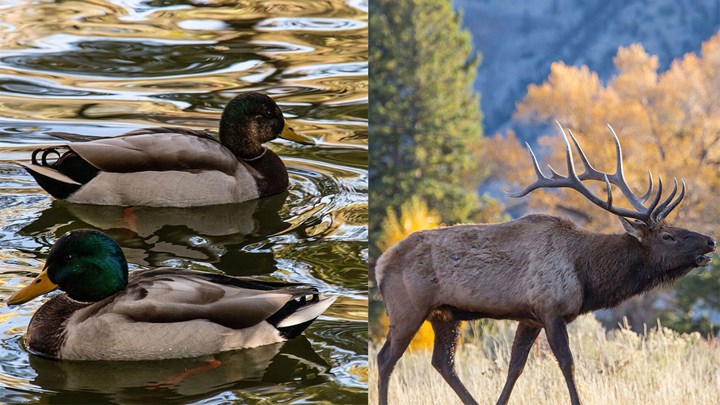
by Cody McLaughlin - Monday, July 8, 2024

If there’s one thing that you have to give credit to hunters for, it’s this. We put our money where our mouths are. Sure, we talk a lot about the best available science in conservation and putting facts and wildlife management over feelings, but it feels fair, and right, to highlight that incredible science when it comes from a place of such tremendous private investment by a group united by none other than our shared passion for recreating in the great outdoors.
The tireless efforts of conservation organizations and the grassroots dollars hunters have invested in them over the years continue to yield extraordinary results, with the National Rifle Association, Ducks Unlimited, the Rocky Mountain Elk Foundation, the National Wild Turkey Federation and many other hunter-backed groups continuing to make significant strides in preserving wildlife habitats, funding research and opening more public lands to hunting (along with the NRA’s efforts to protecting our very right to hunt) with the wise investment of these private resources. These achievements continue to underscore the vital role hunters and conservationists play in safeguarding America's natural heritage.
Ducks Unlimited: Announcing the Conservation of 1 Million Acres for Waterfowl in One Year
As was covered in American Hunter earlier this year, Ducks Unlimited (DU) is celebrating a massive milestone: conserving a full million acres of critical wetland habitat for waterfowl in a single year.
As announced during the DU National Convention in San Diego, Calif., May 29-June 1, the group has conserved an impressive 1 million acres—about the area of Rhode Island—in just one year. Efforts include long-term and permanent projects, such as conservation restorations and easements, in addition to short-term or annual efforts, including agricultural cover crop programs and both new and revisited project sites. Also worth noting, since its founding, Ducks Unlimited has restored or protected more than 18 million acres.
“One million acres of tangible conservation in one year is an achievement that’s nearly 90 years in the making,” said DU CEO Adam Putnam. “This is a testament to the hard work of our dedicated staff and volunteers following years of exponential conservation growth.” Putnam shared how DU doesn’t just advocate for wetlands and that its mission “moves dirt,” adding, “Ducks see it. Communities see it. Partners see it. Each acre represents in-the-field success.” Combined with the group’s ambitious comprehensive campaign in history, Conservation for a Continent,” DU members and supporters are more motivated than ever to make an impact on the wetlands and waterfowl we so cherish.
Rocky Mountain Elk Foundation: 40-Year Anniversary Celebration Touts $8.9 Million Acres of Habitat Conservation
The Rocky Mountain Elk Foundation (RMEF) celebrated four decades of conservation success in May. It is a great example of hunters’ dollars at work as this hunter-backed group has conserved more than 8.9 million acres of habitat for elk as well as other wildlife—a fact that often gets lost in the shuffle as the same habitat, such as old-growth forests that are great for elk, also support wild turkeys, among other species.
“It can’t be overstated: The most valuable thing RMEF volunteers give is their time,” said Kyle Weaver, RMEF president & CEO, in a prepared statement applauding the group’s 40-year milestone. “Because of thousands of them around the country, we put more money on the ground to make more of a difference.” In looking forward, Weaver said RMEF is in a position of strength and influence to be even more impactful for wildlife, hunting, public access and conservation as it advocates for its mission priorities.
Grasping the Scope of Hunters’ Contributions
In sharing how hunters’ contributions matter, what we give to conservation groups is above and beyond the eye-popping $17 billion that the Federal Aid in Wildlife Restoration Act—commonly known as the Pittman-Robertson Act in recognition of its two Senate sponsors—
has raised through our excise taxes since its inception in 1939. Funds created through this hunter-backed act are distributed to each state agency to help them manage wildlife and their habitats. The P-R Act was the very first sustainable source of federal revenue for state wildlife management in America.
Editor’s Note
We hunters have a remarkable conservation success story to share with the general public. Always be sure the non-hunters in your life are aware of how our excise taxes and the license, stamp and permit fees we pay to our state wildlife agencies benefit both game and non-game species. Share how the voluntary contributions we make to America’s numerous hunter-backed, species-specific conservation groups as noted above aid hunters as well as non-hunters—the hikers, birdwatchers, campers, wildlife photographers and other outdoor enthusiasts—also benefit from the many hunter-backed, species-specific conservation groups across America, starting with Ducks Unlimited and the Rocky Mountain Elk Foundation as noted in this article.
Stay tuned for more articles sharing the success of America’s critical hunter-backed groups as we hunters continue protect our cherished and renewable wildlife resources and their habitats into the future.—Karen Mehall Phillips
About the Author
Cody McLaughlin is an outdoor writer, conservationist and hunting advocate based in Alaska. He recently launched Trout Stream Studios as an executive producer for podcasts and livestreams in the hunting and veterans’ affairs spaces, including for the Congressional Sportsmen’s Foundation’s “The Sportsmen’s Voice”and “Blood Origins” podcasts and the Veterans’ Affairs Administration’s National Center for PTSD. McLaughlin serves on the board of the Alaska Outdoor Council, the Last Frontier’s State NRA affiliate, and is a former board member and lead spokesman of the New Jersey Outdoor Alliance.
E-mail your comments/questions about this site to:
[email protected]
Proudly supported by The NRA Foundation and Friends of NRA fundraising.
